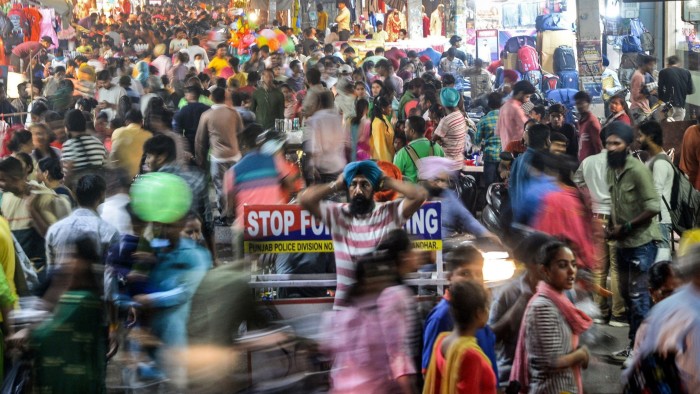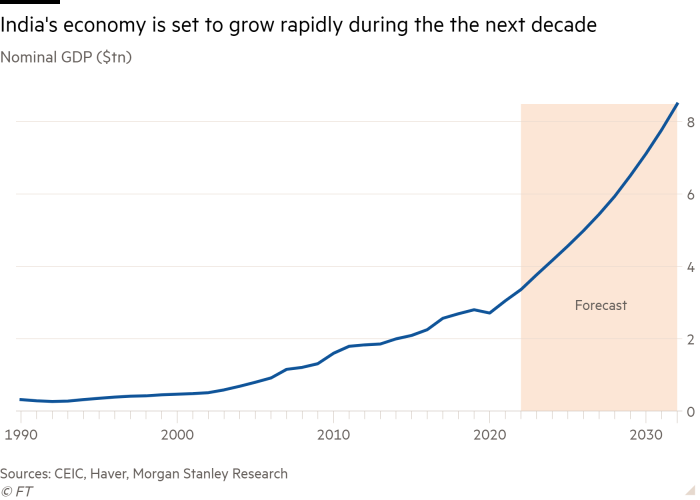India’s coming decade of outperformance

Roula Khalaf, Editor of the FT, selects her favourite stories in this weekly newsletter.
The writer is chief Asia economist at Morgan Stanley
If there were a constant in the ever-changing world of investing, it would be investors’ continuing search for the next big thing. Over the past 20 years, and from a macro standpoint, that story has been about China.
The unprecedented nature of its economic success led to a fundamental reassessment of how we think about the global economy. Over the next decade, while the US and China will remain just as important to global investors, we think the ascendancy of India’s economy will mean it features more prominently on their radars.
The key lies in the size and scale of India’s opportunity set. We forecast that India will be the third-largest economy by 2027, with its GDP more than doubling from the current $3.4tn to $8.5tn over the next 10 years. Incrementally, India will add more than $400bn to its GDP every year, a scale that is only surpassed by the US and China. My colleague Ridham Desai projects that India’s market capitalisation will rise from $3.4tn to $11tn by 2032, the third largest globally.
These projections are underpinned by a confluence of favourable domestic and global forces. The most important change domestically is the shift in policy approach away from redistribution and towards boosting investment and job creation.
This was evident in the introduction of the goods and services tax which creates a unified domestic market; corporate tax cuts; and production-linked schemes to incentivise investment from both within and outside India’s borders. Overlaying this is the emergence of a multipolar world where companies are diversifying their supply chains, with India emerging as a destination of choice.
These forces will integrate India’s fast-growing workforce into the global economy. As it is, India already has a high global market share in services exports, and its lead has only increased since the onset of the pandemic as corporates became more accustomed to remote work.

India is now making concerted efforts to attract investment to boost manufacturing exports. These new factories and offices of the world will draw more employment into the formal sector and more crucially raise productivity growth, creating a virtuous cycle of sustained growth. Indeed, the shift in India’s policy approach is moving it closer to the East Asian model of leveraging exports, raising saving and recycling it for investment.
Against this backdrop, we think that India is entering a phase where incomes will be compounding at a fast rate on a high base. For context, India took 31 years since 1991 to raise its GDP by $3tn. According to our projections, it will take just another seven years for GDP to grow by an additional $3tn.
To contextualise how important this development would be for global investors, the experience of China provides a useful template. India’s GDP today is where China’s was in 2007 — a 15-year gap.
However, from an outlook perspective, India’s working age population is still growing, which suggests that it will have a longer growth runway. India’s median age today is 11 years younger than China’s.
Productivity growth differentials should also swing in India’s favour. Taken together, we think this means that India’s real GDP growth will average 6.5 per cent over the coming decade while China’s will average 3.6 per cent.
China’s industrialisation drive, which has propelled much of its growth over the past 30 years, has been enabled by a buildout of hard infrastructure like roads and railways. India is admittedly playing catch-up and is now making concerted efforts to raise the public expenditure on infrastructure.
But in today’s world, a digital infrastructure is perhaps as important as the physical kind and this is where India is leading and taking a unique developmental approach.
Unlike other economies where private networks have taken root, India has led the world in building public digital infrastructure. This is based on its unique digital identification system, Aadhaar. Further layers are being built, which will leverage this digital infrastructure to better match consumers and businesses, facilitate transactions, and ease the cost of doing business. For instance, the open network for digital commerce set up by the government facilitates ecommerce transactions across a network of buyers and sellers.
To sum up, we estimate India is set to drive a fifth of global growth in the coming decade. We think this offers a compelling opportunity for multinationals and global investors in a world starved of growth.
Comments